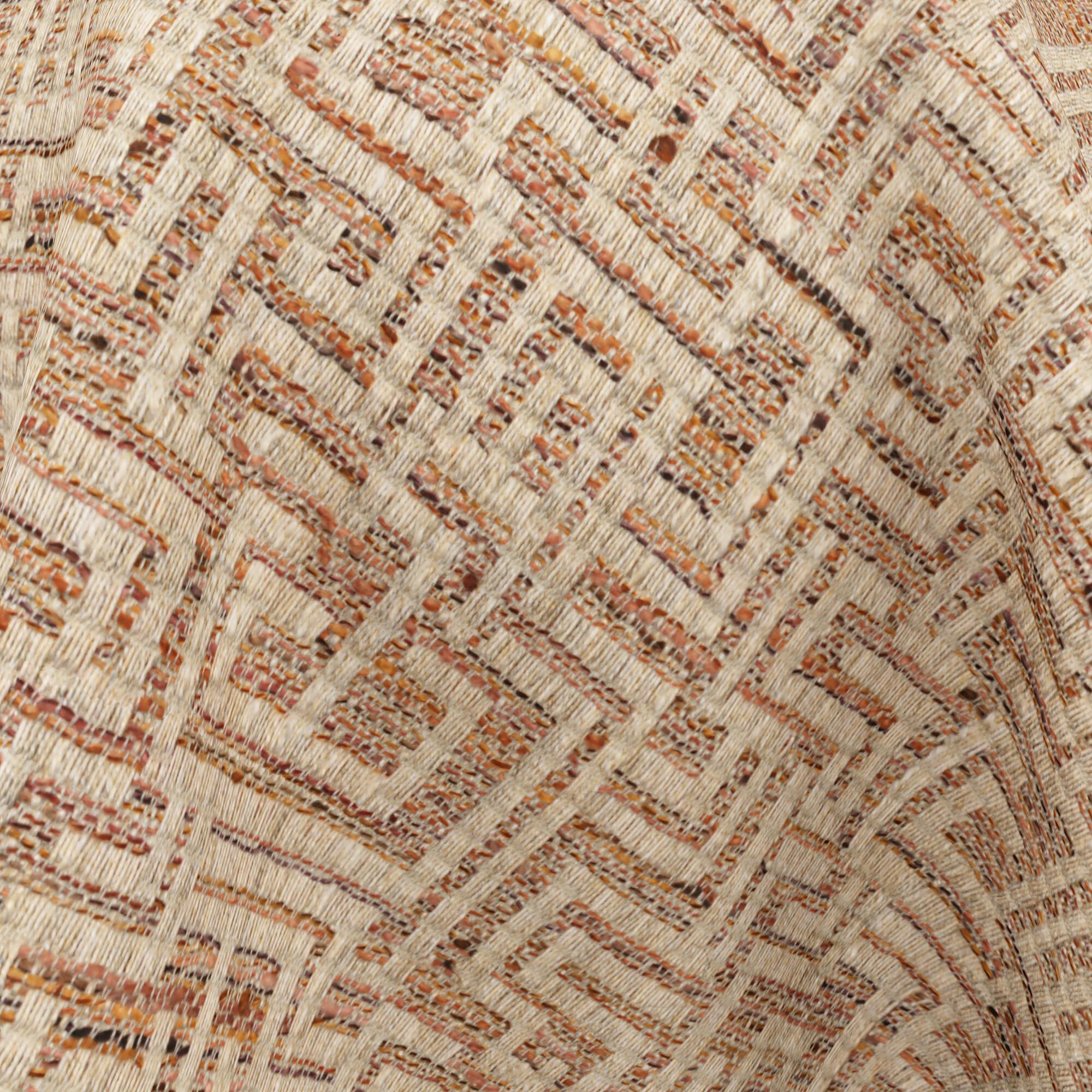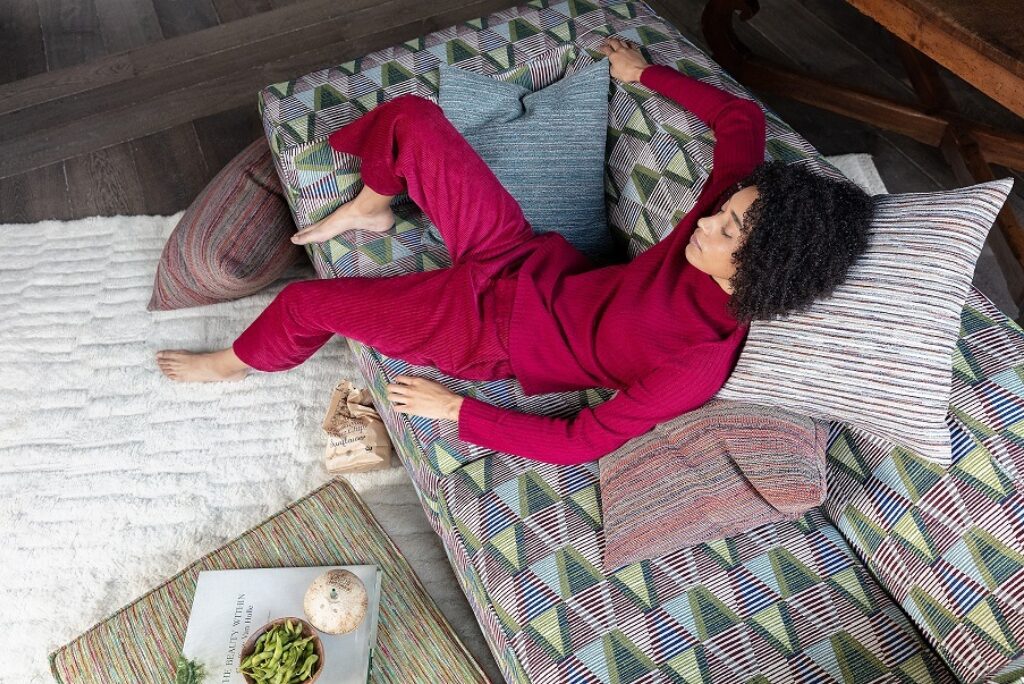Jacquard fabrics: what they are and how to use them in your interiors
At a time, luxurious woven fabrics such as damasks and brocade were the preserve of only the wealthiest members of society. In the eighteenth century, highly skilled weavers would spend hundreds of hours weaving just one colourful piece of cloth by hand for royalty and the elite.
But, as we explore in this blog post, all that changed in 1804 when the 'Jacquard machine' came along and revolutionised the weaving industry. The resulting fabric was highly durable and intricately patterned. More importantly, jacquard fabrics could be produced massively without requiring intensive labour.
Here, we explore the development of this centuries-old weaving technique and look at how jacquard fabrics are used today in homes, hotels and restaurants worldwide.
WHAT ARE JACQUARD FABRICS?
Jacquard fabrics date back to the early nineteenth century and mark the start of a notable innovation in the fabric weaving industry. Before the 'Jacquard machine' invention, intricately woven fabrics such as brocade and damask were made by hand, making them expensive and accessible only to the very wealthiest members of society.
So what is jacquard fabric?
Well, jacquard is a fabric in which the colours and patterns are woven into the fabric itself, rather than being added afterwards with dyes or printing techniques.

The fabric is named after a French weaver called Joseph Marie Jacquard, who invented the machine in 1804 to mechanically manipulate the loom's movements to weave together different coloured threads.
Inspired by the recently-invented self-playing pianos, which used long rolls of paper punched with holes, Jacquard used similar technology to create punch cards to automate the loom’s movements. Each card slotted into the jacquard machine had a series of holes punched into it, corresponding to a specific textile pattern. This new gadget effectively mechanised the weaving process, allowing for complex patterns to be created without requiring intensive labour.
The foundation for the invention of modern computers
Joseph Marie Jacquard's innovative approach is thought to have laid the foundation for the invention of modern computers. His punch card system inspired English mathematician and engineer Charles Babbage when he was creating a mechanical calculating machine. For the design of Babbage's Analytical Engine – generally considered the world's first computer – he used the same punch card method of data input as the jacquard machine.
Jacquard fabrics are used for everything from clothing to bedding to upholstery, featuring various complex patterns. Punched paper cards are no longer part of the jacquard loom weaving process; instead, the looms are operated via computer programs which dictate specific patterns. The result is an efficient process in which luxurious, patterned fabrics can be produced quickly and cost-effectively.
Different types of jacquard fabrics include brocade, a raised silk pattern typically featuring gold or silver thread, and damask, a reversible material in which the pattern woven into it is the same colour as the cloth.
Brocatelle is another type of jacquard which is typified by a heavy fabric with a raised, complex satin pattern. And matelasse, which is commonly used for bedding, features raised patterns with a quilt-like appearance. Jacquard fabrics can be made from a variety of materials such as cotton, silk, acrylic and polyester.
HOW PROFITABLE ARE JACQUARD FABRICS TO THE TEXTILE INDUSTRY?
There's no doubt that the invention of the jacquard machine back in the early nineteenth century revolutionised the weaving industry, allowing intricately patterned fabric to be made cheaply and efficiently.
Today, the demand for quality, patterned fabrics for curtains, upholstery and cushions is higher than ever. Modern, automated weaving techniques allow for the creation of jacquard fabrics on a mass market scale, making them the perfect choice for all types of interior settings.
As well as being stain resistant, FibreGuard's jacquard performance fabrics are highly durable and soft to the touch. These are just some reasons why they have become a firm favourite with designers of residential, commercial and hospitality settings worldwide.
According to an analysis report from Research and Markets*, the luxury interior fabric market size in North America and Europe is expected to reach USD 2.7 billion by 2028. This represents an increase in the compound annual growth rate (CAGR) of 11.9% in the 2021-2028 period. - North America & Europe Luxury Interior Fabric Market Size, Share & Trends Analysis Report 2021-2028 from Research and Markets
Research has also shown that upholstered furniture, in particular, is one of the fastest-growing segments of the furniture industry. With changing lifestyles and the expansion of real estate, consumers are increasingly drawn towards high quality, comfortable and visually attractive upholstered beds, sofas and chairs.
Jacquard raw materials are predicted to see one of the highest compound annual growth rates of 12.4% in the 2021-2028 period, which is further indicative of the increasing demand for luxury, patterned fabrics. And because jacquard fabrics are extremely hard-wearing and resistant to fading, they represent a solid fabric choice for all types of drapery and upholstery.
5 FACTS ABOUT JACQUARD LOOM WEAVING TECHNIQUES
- The original 'Jacquard machine' mechanism involved the use of thousands of punch cards laced together. Each row of punched holes corresponded to a row of a textile pattern, allowing greater efficiency in the creation of complex, woven patterns.
- In the fabric weaving process, jacquard fabric is created by passing different coloured weft (horizontal) threads over and under warp (vertical) threads to build an intricate design with a tapestry-like finish.
- Present day jacquard fabrics are made via computerised jacquard looms that can create a myriad of highly complex patterns. Featuring thousands of hooks threaded with different yarns, electronic jacquard looms are capable of weaving very large pieces of fabric quickly and efficiently.
- As part of the jacquard loom weaving process, spun yarn is fed into the weaving apparatus and the desired pattern is selected via computer. The finished fabric is then exposed to chemicals to enhance durability and heat resistance.
- Jacquards can be made from a variety of materials including cotton, silk, acrylic and polyester to create a patterned fabric that is fade-resistant and highly durable.
HOW TO USE JACQUARD FABRICS IN YOUR INTERIOR
Thanks to the inherent pattern woven into the fabric, jacquards are a great way to add luxurious texture and colour to any interior. For a neutral scheme, they can bring pattern and vibrancy to a space when used to create colourful curtains or beautiful upholstered furniture. And for a bold, maximalist look, jacquard fabrics are the perfect way to bring in additional layers of characterful pattern.
Jacquard performance fabrics are known for their durability and colourfast qualities, so the benefits of using them goes way beyond pure aesthetics.
These highly practical qualities make FibreGuard's jacquard fabrics the natural choice for commercial and contract settings as well as for residential interiors. FibreGuard's premium-quality jacquards set a global furnishing fabrics standard. They are resistant to stains, abrasion, pilling and fading, and are specifically designed to withstand the wear and tear of even the most demanding commercial environments.
Read about all of our mechanical textiles testing procedures. >
With their richly-woven, luxurious feel, jacquard fabrics are guaranteed to bring a touch of luxe to any interior. And thanks to the huge range of jacquard designs now on offer, there are multiple ways to introduce this versatile fabric into any interior scheme.
FibreGuard jacquards come in a wide array of designs, ranging from bold damasks to stunning stripes and on-trend geometric patterns. They are available in designs suitable for both indoor and outdoor settings to ensure they can meet all the demanding requirements of a contract environment. Head over to stain-resistant fabrics to learn more about their properties.
FIBREGUARD JACQUARD SHOWCASE
One of our best-selling jacquards is found in our FibreGuard Pro range, and even though it's gorgeously soft, it scores an impressive 37,000 on the Wyzenbeek rub test and 40,000 on the Martindale rub test. It has a high-end, wool-bouclé look and comes in various colours.
Our FibreGuard Outdoor collections feature textured jacquard fabrics, too, made from solution-dyed olefin, which is perfect for outdoor sofas and cushions. This design is surprisingly soft to the touch, especially when compared with equivalent acrylic fabrics designed for outdoor use.
Moving indoors, our jacquard collections offer subtle, unobtrusive weaves and bolder patterns, such as a striking Greek key pattern or dramatic flame stitch. They offer a timeless appeal with true versatility, providing a ‘mix-and-match designer’s library of geometric patterns woven in a range stretching from soft neutrals and subdued, earthy colours to bolder contrast designs perfect for contemporary or mid-century modern style interiors.
FibreGuard fabrics are unique in the market because of their embedded stain-free technology, which repels problematic substances such as coffee, wine or ketchup.
And unlike other easy-to-clean fabrics, this stain-resistant effect is permanent, which means it will not deteriorate after multiple washings or prolonged use. Check out our Cleaning Hub for full cleaning instructions.
FIBREGUARD'S JACQUARD FABRICS ALSO BOAST IMPRESSIVE ECO CREDENTIALS
The 100% polyester yarns require less water during washing because of their low absorption properties. They also save energy during drying because of their higher-than-average dehydration speed.
Also, as part of FibreGuard's STANDARD 100 by OEKO-TEX® environmental certification, all our fabrics are guaranteed entirely safe for skin contact.
WHERE TO FIND FIBREGUARD JACQUARD FABRICS
FibreGuard’s performance fabrics are available worldwide. Contact our sales team today to find your nearest representative or reseller.
